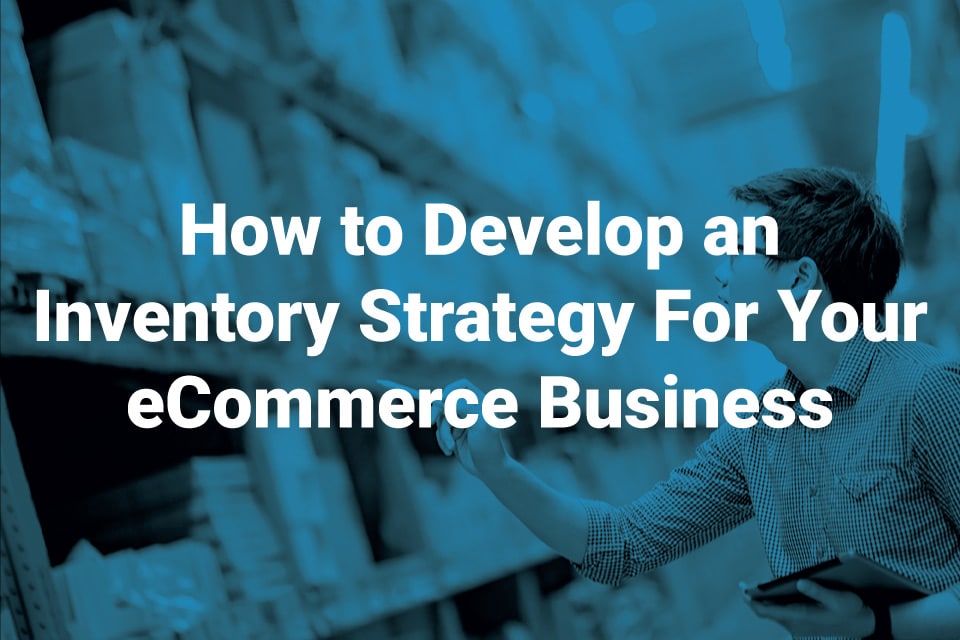How to Develop an Inventory Strategy For Your eCommerce Business

During the pandemic, there was a profound shift in the world of eCommerce. Not only did online shopping skyrocket, but things like short shipping times, robust digital marketplaces, and up-to-date tracking information became the norm. As did disruptions, low stock, and month-long waits as back-orders piled up.
Unfortunately, repercussions from the pandemic are still affecting business operations and the global supply chain. Now, more than ever, you need to expect the unexpected to keep customers happy and loyal.
The best path forward — especially in dealing with supply chain logistics and headaches — is an agile, creative, and clear-headed approach. The crux of which is developing a comprehensive yet flexible inventory strategy for your eCommerce business.
Consider, too, working with a third-party fulfillment center like Ship My Orders. We’re a leading 3PL with a global customer base and understand what eCommerce businesses currently face.
Keep reading to learn more about strategies for inventory control in 2022.
Why You Can’t Overlook Inventory Strategy, Control, or Stock Replenishment in 2022
How can you balance reliably meeting your customers’ needs and making money, while avoiding overstocking and racking up storage bills? By creating a strategy that involves a combination of precise stock replenishment and elastic inventory control.
First, consider your current stock replenishment system. Can it scale with a surge in demand? Or would you sell out and lose business as your frustrated customers looked elsewhere?
As evidenced by the beginning of the pandemic, you wouldn’t be alone. While perhaps no one could have predicted the months-long toilet paper frenzy, it provides an excellent example of why you need a system that can handle swift, widespread fluctuations.
Inventory control helps you figure out how best to time your stock replenishment windows. It is the first critical piece of an inventory strategy (hence why it has its own section). But over time, it can also help you account for what sells and what doesn’t.
How to Develop an Inventory Strategy
Developing an inventory strategy means creating a comprehensive view of your stock. You’re aware of it as it moves through the supply chain from raw materials to finished product to final purchase and delivery to your customer. Your strategy should also account for the warehouse piece, including storage, auditing, and offloading old stock.
Note, since all the following points impact and influence each other, you could technically use any of them as a jumping-off point. But we suggest you start by crunching your numbers. This will maximize your profits and drive customer loyalty.
1) What is Your Average Inventory Turnover Ratio?
Inventory turnover ratio helps you put together a picture of your inventory’s timeline from creation to sold, signed, sealed, and delivered to your happy customer.
To figure out this KPI (key performance indicator) number, use the following formula: divide your net sales for stock sold by the average worth of your inventory in a specific time period of your choice.
Once you pick a time frame, say a month or a year, you can also fine-tune the following steps, too.
2) Shelf Life Optimization: Par Levels and Lead Time
Now that you know the numbers for your inventory turnover, you can assess the flip side of it: shelf life. Is your stock moving? How much? When?
Though you want to turn over stock quickly and efficiently — you also don’t want to stock-out. Nor do you want to waste overhead by racking up storage costs. So, if you optimize your stock’s shelf life, you can better pace when and how much stock you need to re-order.
Taking this information into account, you set a “par level,” or a depletion percentage of your stock that tells you the best time to order more.
However, since demand drives par levels, different items will have different reorder points, which can sometimes be hard to keep track of. But, that’s why par levels are also called safety stock, because it ensures that you always have a backup in case of an abrupt increase in demand.
3) A Full Audit
Finally, put it all together and do a full audit of your inventory. (Especially if it’s been a while.)
This will help you determine what you need more of, what you need to get rid of, and what might be costing you. Consider, too, paring down your inventory to high-demand products that quickly sell, and getting rid of slow-moving or stuck stock.
Factors to Consider When Developing an Inventory Strategy
Now that you have a full audit and have an inventory strategy, you can hone it by accounting for the following factors. First up: how to spot-check the accuracy of your audit.
Cycle Counting
After you do a full audit, cycle in regular, smaller audits of specific items at specific times. This will allow you to double-check your full audit numbers, too.
First in, First Out, or FIFO
First to arrive? First to go. Obviously, this is critical if you are dealing with perishable stock. However, with non-perishables, this system helps to keep your shelves clear of depreciating items, whether in terms of cost or fashion.
Pareto Principle
Also called the ABC analysis, this principle helps you streamline stock, as it recognizes:
- (Usually) 80% of your revenue comes from about 20% of your stock.
- So, using the inventory strategy numbers and insights that you’ve already figured out – you should be able to narrow down on your bestselling and high-priced “A” items, your average “B” items, and everything else, your “C” items.
- Now, you can prioritize your stock by revenue and also audit accordingly, easy as ABC.
Next, you’ll want to factor in the outside influences.
Trends
- If you learn the variations in your customers’ buying patterns, you can leverage them into profit.
- You can account for changes in demand throughout the year or even month to month.
- However, tempting as it is to stock up on discounted items at the end of a season, you do not want to get stuck with stock that you can’t move.
Forecasting
- Use the information you’ve gathered from your customer’s buying trends to anticipate when to order stock and how much of it.
Options for Moving Old Stock
- “Bundle” old stock with other items via tempting discounts.
- Negotiate a return with your supplier.
- Keep in mind if you go this route, you may need to compromise a bit, as offloading old stock is usually better for you, the seller, than your supplier.
Storage
- It should go without saying, but keep your warehouse or storage space impeccable. Also, shift items that are more high-priority to areas of easier access.
- Finally, consider looking into a fulfillment warehouse.
The Role of Order Fulfillment In Your Inventory Strategy
For a small eCommerce business, 3PL order fulfillment services range from storage and shipping options to inventory management and customer service. Big or small, if your business is growing, or you are spending too much time wrestling with supply chain logistics, consider outsourcing.
Start by doing a cost analysis of the offered services and see where you might save money on order fulfillment. Also, make sure to thoroughly investigate your potential 3PL. You want a company that offers real-time analytics tracking, reasonable costs, and can scale with your business growth.
Hire Ship My Orders as Your Fulfillment Partner
A thorough inventory strategy has to account for a lot of time, money, and movement. It needs to factor in your supplier’s timeline and your own. It gauges inventory turnover, trends, and forecasting to figure out the best amount of stock to have on hand and when to reorder. It is a comprehensive view, yes, but only so that you can have enough flexibility to grow your business.
That’s no mean feat.
So, if you are considering an order fulfillment service, don’t you want a partner that will feel like an extension of your own company? One with scalable technology, and a dedicated and consistent team who can handle all your customer’s demands? One that wants to work with you?
Contact Ship My Orders today for a free quote and let’s find out if we’re a good fit.

-1.png)


